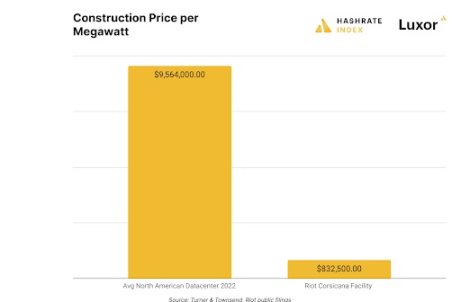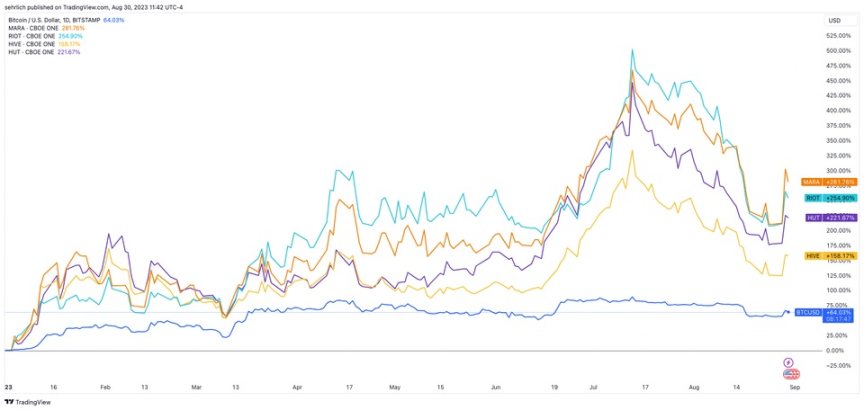Can Bitcoin miners successfully transition to artificial intelligence and perfectly catch the next wave?
Can Bitcoin miners transition to AI and catch the next wave?Author: Colin Harper, Content Manager at Luxor Technologies. Translation: Luffy, Foresight News.
The Bitcoin industry, especially the mining industry, is no stranger to hype. And now, a new technology has emerged: artificial intelligence.
ChatGPT and other large-scale language model programs (commonly referred to as AI) have made waves in the workplace and the online world this year. Consequently, references to artificial intelligence naturally appear in cryptocurrency news.
For example, some Bitcoin miners openly state that they are seizing opportunities in the field of artificial intelligence, trying to make outdated hardware useful. However, this does not mean that every company is performing the same functions as AI data centers or achieving the same scale. In fact, the tasks performed by this outdated hardware are very different from those required for typical AI services, and some miners are just trying to profit from the hype.
- August Cryptocurrency Market Summary Most indicators further corrected, and the total on-chain transaction volume decreased by 6.3% after adjustment.
- LianGuai Daily | The US SEC has postponed its decision on the Bitcoin spot ETF; UK cryptocurrency travel rules come into effect today.
- Steady profit from rebound? An article lists 4 volatile tokens with the best performance.
Can Bitcoin miners provide AI services? The situation is complex.
In the past few months, HIVE, Hut 8, and other Bitcoin mining companies have announced new high-performance computing (HPC)/artificial intelligence strategies. Most of their computer hardware has been phased out due to Ethereum transitioning to a proof-of-stake consensus mechanism, which ended the era of Ethereum mining. Some miners claim that they can rent out their computing power for high-performance computing (although Hut 8 has been doing so since 2022).
High-performance computing is a general term for any number of data center tasks. However, when miners talk about HPC, they specifically refer to cloud computing or graphics rendering. Hut 8 earned $4.5 million from such services in the first quarter and $4.3 million in the second quarter, while HIVE’s pilot project earned $200,000 in the first quarter, although the mining company did not mention any HPC revenue in its filings with the SEC for the second quarter. Hut 8 has signed a contract with Interior Health in British Columbia to provide high-performance computing services until 2028. The company acquired a 6 MW facility that provides these services when it acquired Toronto’s TeraGo data center business in 2022.
These are different types of computations compared to training AI models or providing support for ChatGPT. Miners do not have the appropriate computing equipment to support such work, nor do they have the necessary power and network infrastructure (AI computing requires at least 1 TB of network bandwidth per second, which industrial-scale mining facilities cannot meet as their bandwidth is typically 1 GB per second).
A genuine AI data center may cost 10 to 20 times the price per megawatt of a Bitcoin mining farm (according to data from the ERCOT power grid operator, one megawatt can power around 200 households in Texas). Additionally, the power costs of such facilities would be twice as high as that of miners, potentially reaching 15 cents per kilowatt-hour. In the United States, Bitcoin miners typically pay 5-8 cents per kilowatt-hour for electricity.
The cost of operating HPC facilities is much higher than that of Bitcoin miners.
Riot Platforms estimates that the cost per megawatt of power capacity for the Bitcoin mine it is about to build near Corsicana, Texas is $833,000, with an initial construction capacity of 400 megawatts.
In contrast, the average cost of North American HPC data centers is $9.5 million per megawatt (according to Turner & Townsend’s 2022 Data Center Index Cost calculations).
The high cost is due to the complexity of these data centers. They require higher quality power infrastructure and network equipment, not to mention they need more space, better cooling, and more powerful backup generators to ensure 99.99% uptime during power outages. In short, these miners do not have the funds or market capability to build AI systems, let alone the ability to build a traditional data center.
This cost only applies to traditional high-performance data centers and may not apply to data centers with driving engine functions such as Open AI’s ChatGPT and Microsoft’s Bard.
Miners may try high-performance computing, but not artificial intelligence
Many Bitcoin mining companies were born out of a sudden shift in business lines, but at this stage of development, these companies should be cautious when trying to curb the hype of technologies such as HPC/AI.
The two largest publicly traded Bitcoin miners, Riot Platforms and Marathon Digital, announced their Bitcoin mining businesses in 2017, but these companies were already listed before they ventured into cryptocurrency. Marathon Digital’s predecessor was Marathon LianGuaitent Co., which profit from buying and selling various technology patents, while Riot was a pharmaceutical company.
Both companies have now become among the world’s largest Bitcoin miners, so this transformation has paid off.
However, for a major Bitcoin miner, converting its mining farms into AI data centers would be extremely difficult and expensive. It should also be noted that in the traditional data center market, miners will be competing with the world’s most powerful tech companies such as Google, Amazon, and Microsoft.
Applied Digital is an exception: it is a data center company that also hosts Bitcoin mining equipment for clients. This distinction is important because traditional data center operators find it easier to deploy Bitcoin mining equipment on site than miners starting from scratch to build a data center. The AI hype wave in 2023 pushed Applied Digital’s stock price to $10.24, but it has since fallen significantly to $5.68 at the time of writing this article. As shown in the following figure, Applied Digital and mining stocks are currently in a hot state overall, so we recommend investors considering these stocks to proceed with caution.
This year, Bitcoin mining stocks have soared along with related assets, but many hope that artificial intelligence can regain the bullish momentum.
Summary
When the speculation subsides, the market will tell us which companies are in a favorable position to seize the wave of artificial intelligence.
For miners, they can provide graphic rendering services, but they do not use their mining hardware for ChatGPT. So, when you see artificial intelligence in a press release, don’t be confused, it may not be what you imagine.
We will continue to update Blocking; if you have any questions or suggestions, please contact us!
Was this article helpful?
93 out of 132 found this helpful
Related articles
- Binance Research Emerging Stablecoins and an Overview of Market Competition
- LianGuai Morning News | SEC decides to postpone the registration of 7 Bitcoin ETFs including BlackRock
- Binance Research Report Emergence of New Types of Stablecoins, Overview of Market Competition Pattern
- Review of the Cryptocurrency Market Summer Trends Mixed Bullish and Bearish News, Doubts about the Sustainability of the Rise.
- Bitcoin Spot ETF Application Inventory When will it be approved?
- Interpreting the lending platform Fuji Money unlocking the financial potential of Bitcoin Layer2
- Messari Founder Most Bullish on Cryptocurrency Job Market







